The Scottish Health Survey 2023 - volume 1: main report
This report presents results for the Scottish Health Survey 2023, providing information on the health and factors relating to health of people living in Scotland.
6 Physical Activity
Jordan Fox
6.1 Introduction
The World Health Organisation lists physical inactivity as one of the five key modifiable behaviours which increase the risk of five major non-communicable diseases (NCDs), along with tobacco use, unhealthy diet, air pollution and the harmful use of alcohol [103]. Physical activity is beneficial for physical health, maintenance of a healthy weight, mental health (including maintaining cognitive ability), childhood educational attainment and overall wellbeing[104]. A lack of physical activity can result in preventable cases of conditions such as cardiovascular disease, depression, dementia, hypertension, musculoskeletal disorders and type 2 diabetes[105],[106].
The UK Chief Medical Officers’ Physical Activity Guidelines[107] (updated 2019) were constructed as advice to the general population about the recommended frequency, intensity, time and types of physical activity required to prevent major chronic disease and to maintain health.
The guidelines recommend that, for good physical and mental health, adults should aim to be physically active every day. Any activity is better than none, and more is better still. Each week, adults should accumulate at least 150 minutes of moderate intensity activity; or 75 minutes of vigorous intensity activity; or even shorter durations of very vigorous intensity activity; or a combination of moderate, vigorous and very vigorous intensity activity. The guidelines also recommend that muscle strengthening activities are undertaken on at least two days a week but that any strengthening activity is better than none. Sedentary time should be minimised as far as possible.
For children and young people, the recommendations[108] are that those aged 5 to 18 years should endeavour to participate in an average minimum of 60 minutes of moderate to vigorous intensity physical activity per day, which should include activity that develops movement skills and which strengthens bones and muscles while spending less time sitting or lying down and breaking up periods of physical inactivity with sporadic movement and activity.
6.1.1 Policy background
The Active Scotland Outcomes Framework[109] sets out the shared vision and goals which have shaped the approach the Scottish Government and a wide range of partner organisations have taken to supporting and enabling people in Scotland to be more physically active. The framework facilitates a cross-government commitment to the importance of physical activity and sport in achieving a wide range of outcomes, including the percentage of schools meeting the physical education target.
The Active Scotland Delivery Plan (A More Active Scotland)[110], published in 2018, identified a wide range of actions across all sectors with the overall aim of a 15% relative reduction in reported physical inactivity in adults and teenagers by 2030. This was to be achieved through addressing existing inequalities in access to opportunities for physical activity, barriers to participation and how to develop both the confidence and competence needed to encourage lifelong participation in physical activity and sport among children and young people.
International evidence and global advice from WHO is clear that improving levels of physical activity is a complex public health issue with multiple interacting influences. Scotland is one of the first countries in the world to undertake the translation of WHO guidance into a national context. Public Health Scotland (PHS) have used this approach to inform the national and local direction of physical activity in Scotland. The result is described in detail at A systems-based approach to physical activity in Scotland[111].
The Scottish Government published a new Physical Activity Framework for Scotland[112] in October 2024 based on the PHS work.
6.1.2 Reporting physical activity in the Scottish Health Survey
In this chapter, the following data are presented:
- adults’ (aged 16+) adherence to recommended physical activity levels, including muscle strengthening activity levels
- children’s (aged 5 to 15 years) summary activity levels (including and excluding school-based activities)
- sedentary activity for adults and children
Figures are reported by age, sex and area deprivation.
Breakdowns by deprivation are presented in Scottish Index of Multiple Deprivation (SIMD) quintiles. To ensure that the comparisons presented are not confounded by the different age profiles of the quintiles, the data have been age-standardised. For a detailed description of both SIMD and age-standardisation as well as definitions of other terminology used in this chapter and for details on the 2019 UK Physical Activity Guidelines and data collection methods for physical activity, please refer to Chapter 2 the Scottish Health Survey 2023 - volume 2: technical report.
6.1.3 Comparability with other UK statistics
The Health Survey for England [113], Health Survey Northern Ireland[114] and the National Survey for Wales[115] provide estimates of physical activity prevalence for adults in the other UK countries. The surveys are conducted separately and have different sampling methodologies, so physical activity prevalence estimates across the surveys are only partially comparable.
The Active Lives Children and Young People survey[116] in England, the Children’s Sport Participation and Physical Activity Study in Northern Ireland and the Schools Sports Survey in Wales[117] provide estimates of physical activity prevalence for children in the other UK countries. The surveys are conducted separately and have different sampling methodologies, so physical activity prevalence estimates across the surveys are only partially comparable.
6.2 Results
Summary
In 2023:
- The proportion of adults meeting the recommended levels of physical activity (63%) was not significantly lower than in 2022 (65%) and remained within the overall range recorded between 2012 and 2022 (62-69%). As in previous years, a higher proportion of men reported having met the guidelines (68%) compared with women (59%).
- Adults aged 75 and over were least likely to have met the physical activity guidelines (37%), although men in this age group were more likely to have done so compared with women (45% and 30% respectively).
- Only one in two adults living in Scotland’s most deprived areas met the recommended level of physical activity (50%), one of the lowest proportions in the 2012 – 2023 timeseries.
- Highest adherence to MVPA and muscle strengthening guidelines was amongst 16-24 year olds.
- Adherence to recommended physical activity levels was lowest for children aged 13-15. A notably lower proportion of girls aged 13-15 met the recommended physical activity level compared with boys in this group (43% and 67% respectively).
- Adults aged 65 and over recorded the highest amount of time spent on sedentary activities in 2023.
- Children aged 2-15 spent an average of 3.7 hours per day on weekdays and 5.1 hours per day at weekends on sedentary leisure activities, similar to levels seen since 2019. The amount of time spent on sedentary activities among children increased as they got older.
6.2.1 Around six in ten adults in Scotland met the recommended levels of physical activity in 2023
In 2023, 63% of adults met the guidelines for moderate or vigorous physical activity (MVPA). This is not significantly lower than in 2022 (65%) and remains within the overall range recorded between 2012 and 2022 (62%-69%).
As in previous years, a higher proportion of males reported having met MVPA guidelines (68%) compared with females (59%).
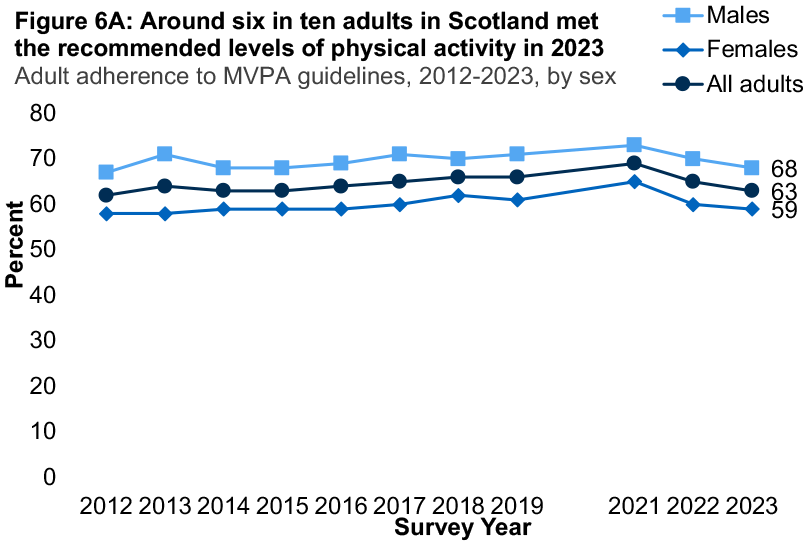
6.2.2 Older adults were less likely to adhere to the physical activity guidelines, particularly women
As in previous years, younger adults were more likely to have met MVPA guidelines compared to older adults in 2023, with the proportion adhering to the guidelines decreasing from 74% among 16-24 year olds to 36% among those aged 75 and over.
Males were more likely than females to adhere to the guidelines across most age groups, most notably among those aged 25-34 (80% and 63% respectively) and those aged 75 and over (45% and 30% respectively).
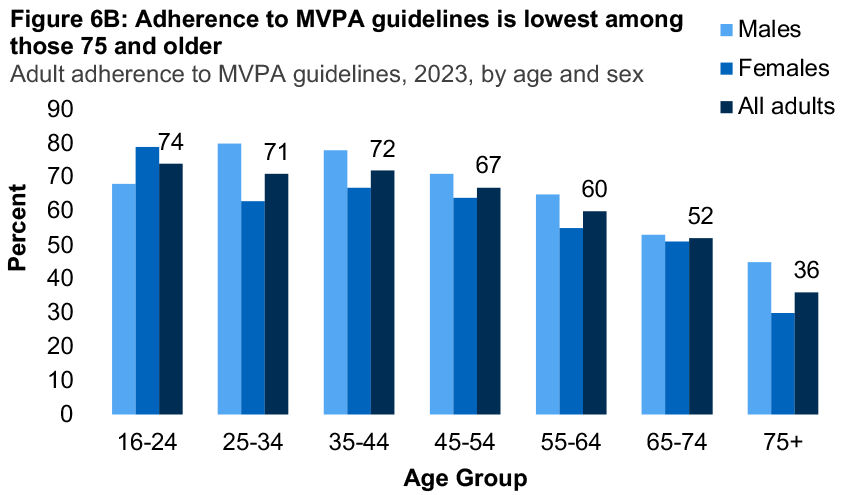
6.2.3 One in two adults living in Scotland’s most deprived areas did not meet the recommended level of physical activity
Across the timeseries, higher proportions adhering to the MVPA guidelines have been recorded among those living in the least deprived areas compared with those living in the most deprived areas, although the extent of the difference between these groups has shown some variation.
In 2023, 72% of those living in the least deprived areas adhered to these guidelines compared with 50% of those in living in the most deprived areas. MVPA adherence among those living in the most deprived areas in 2023 is at the lower end of the range observed since 2012 (49%-57%). Table 6.3
6.2.4 Highest adherence to MVPA and muscle strengthening guidelines was amongst 16-24 year olds
In 2023, around three in ten adults met both MVPA guidelines and muscle strengthening recommendations (29%). As reported for previous years, males (32%) were more likely than females (26%) to have met both guidelines.
Adherence to the MVPA and muscle strengthening recommendations decreased with age, from 46% of those aged 16-24 to 9% of those aged 75 and older.
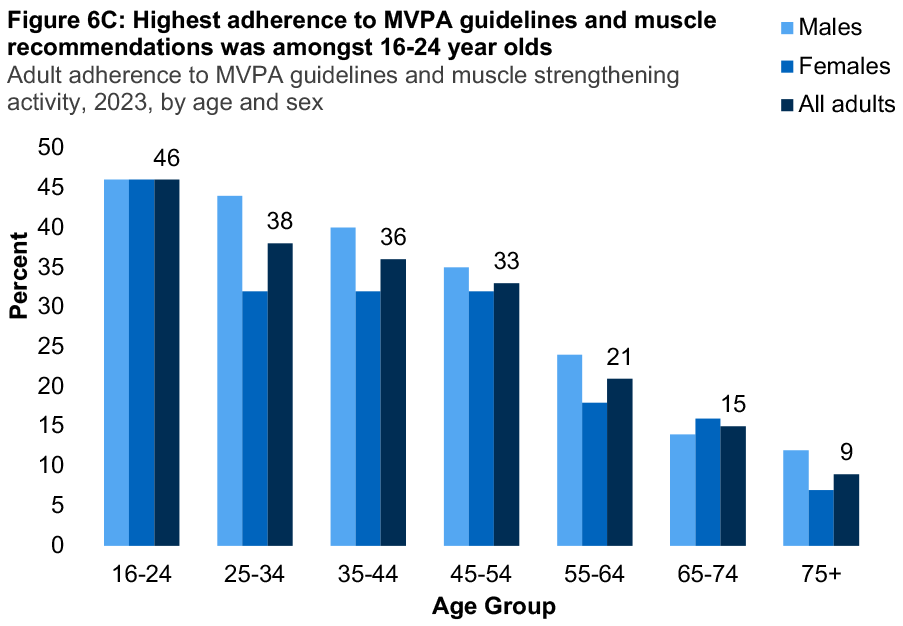
6.2.5 Almost three quarters of children met the physical activity guidelines
Including school-based activities, 72% of all children aged 5 to 15 met the physical activity recommendation in 2023. Since 2008, this proportion has been in the range 69%-76%, with the 2023 proportion around the mid-point of this range. The difference recorded by sex for guideline adherence including school-based activities (75% for males and 70% for females) was not significant.
Around six in ten children met the physical activity guidelines in 2023 when school-based activity was excluded (62%), with males (66%) more likely to have done so than females (58%). The 2023 figure is within the range of 59%-68% recorded since 2003. Table 6.5
6.2.6 Adherence to recommended physical activity levels was lowest for children aged 13-15
As observed in previous years, the proportion of children that met physical activity guidelines in 2023 was lowest among 13-15 year olds (56%). The age groups with the highest adherence to these recommendations were the 5–7 year olds (81%) and 8-10 year olds (80%).
Adherence to the recommendations among females decreased from 74% among those aged 11-12 to 43% among those aged 13-15. This resulted in a twenty-four percentage point difference in adherence among females aged 13-15 compared with males in the same age group (67%).
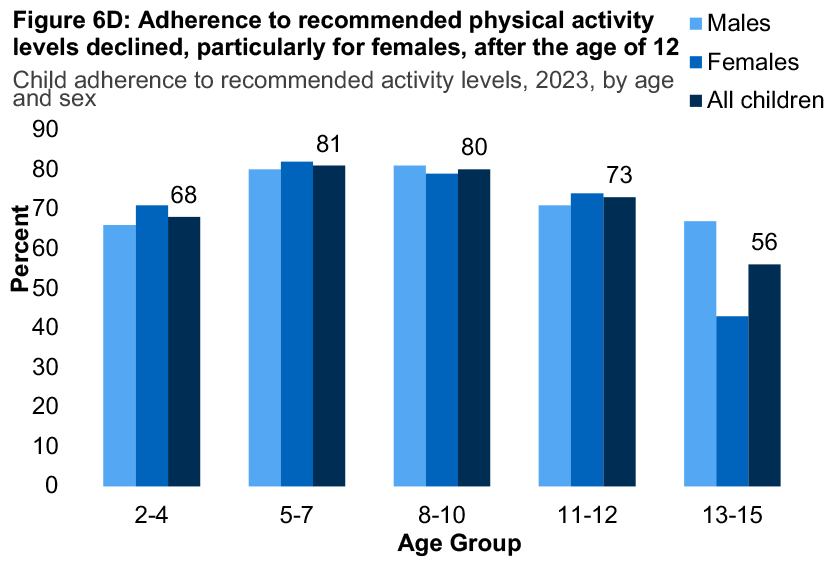
6.2.7 Adults aged 65 and over recorded the highest amount of time spent on sedentary activities in 2023
Adults spent 5.7 hours on average per day on the weekday and 6.5 hours during the weekend on sedentary leisure activities in 2023.
The oldest age groups recorded the highest mean hours spent on sedentary activities per day with a mean of 6.9 hours among those aged 65-74 and 7.4 hours among those aged 75 and older on weekdays, and a mean of 7.1 and 7.5 hours respectively on weekends.
Those in the 25-54 age group spent the least amount of time, on average, on sedentary activities, with means in the range 4.7-5.1 hours on weekdays and 5.8-6.1 hours on weekends.
Similar patterns were observed for males and females.
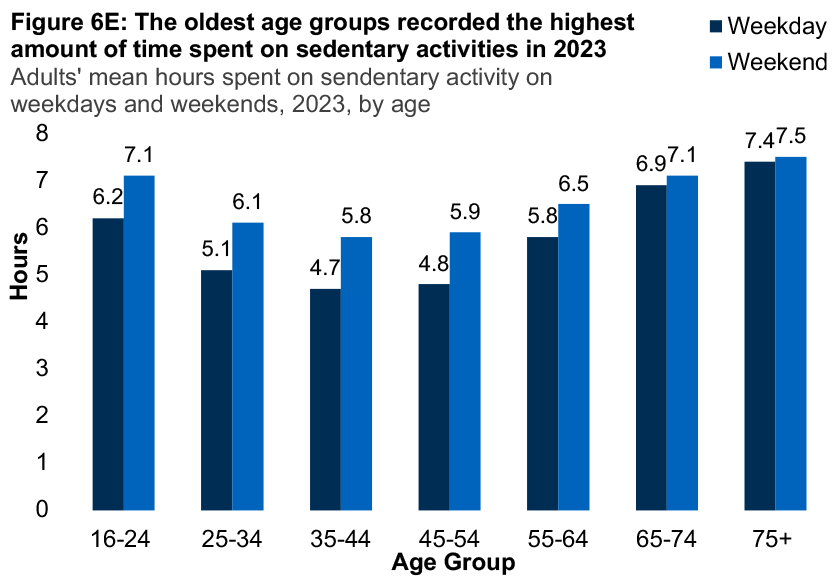
6.2.8 Children's sedentary time remained similar to recent years
Children aged 2-15 spent an average of 3.7 hours on weekdays and 5.1 hours at weekends per day on sedentary leisure activities in 2023. These means remain similar to those recorded since 2019 (3.6-3.7 hours on weekdays and 4.9-5.1 hours on weekends).
The proportion of children with sedentary activity in the top quartile for weekdays (over four and a half hours of sedentary time) in 2023 was at the highest level in the timeseries at 26%. Similarly, the proportion in the top quartile for weekend sedentary time (seven hours or more) was also at its highest level at 28%. Table 6.8
6.2.9 Sedentary time increased with age among children
The mean amount of time spent on sedentary activities on weekdays rose from a mean of 3.2 hours among all children aged 2-7 to 4.7 hours among those aged 13-15. A similar pattern was evident for weekends with an average of 4.0 hours among those aged 2-4 which rose to 6.4 hours among children aged 13-15.
The mean amounts of time spent on sedentary activities during the weekday and weekend were similar for boys and girls.
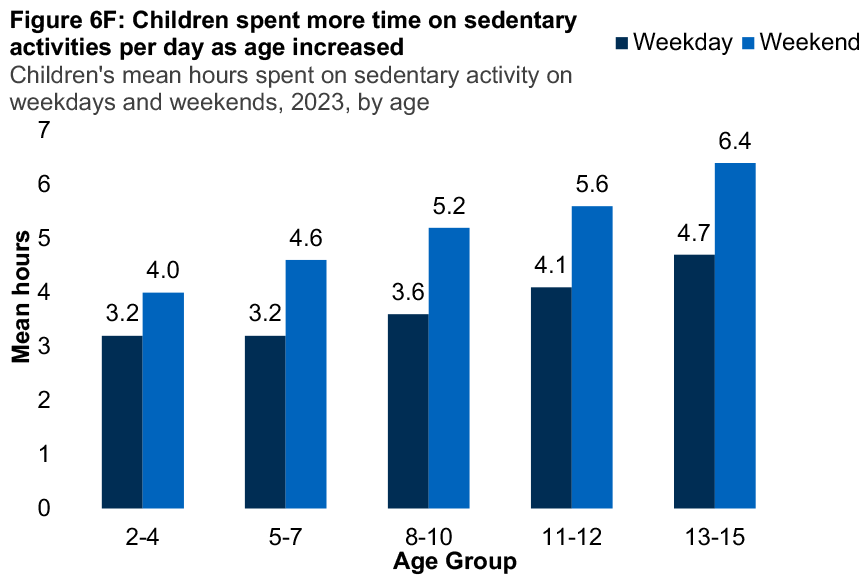
Notes
- Some caution should be exercised when interpreting data for 2021 within any time series data presented due to some methodological changes during the pandemic. Please see the Scottish Health Survey 2022 - volume 2: technical report for more information.
- Physical activity guidelines for those aged 16-18 are at least one hour of moderate or vigorous activity each day. As SHeS participants of that age were given the adult questionnaire, which does not ask separately about each day, they have been included in this table assessed against the adult criteria.
- For 2-4 year olds, the recommendations are for 180 minutes activity per day, of which, for 3-4 years olds only, at least 60 minutes should be moderate or vigorous. SHeS does not completely measure activity that does not reach the threshold of moderate or vigorous, so figures for 2-4 year olds are based only on meeting the 60 minutes MVPA recommendation.
- Sedentary time excludes time spent sedentary whilst at work, school or college.
Table list
Table 6.1 Adult summary activity levels, 2012 to 2023, by sex
Table 6.2 Adult summary activity levels, 2023, by age and sex
Table 6.3 Adult summary activity levels (age-standardised), 2023, by area deprivation and sex
Table 6.4 Adult moderate/vigorous physical activity (MVPA) and muscle strengthening physical activity, 2023, by age and sex
Table 6.5 Children summary activity levels (including and excluding school-based activities), 1998 to 2023, by sex
Table 6.6 Children summary activity levels (including and excluding school-based activities), 2023, by age and sex
Table 6.7 Adults' sedentary time, 2023, by age and sex
Table 6.8 Children's sedentary time, 2012 to 2023, by sex
Table 6.9 Children's sedentary time, 2023, by age and sex
References and notes
1 Noncommunicable Diseases, Rehabilitation and Disability (who.int)
2 https://www.who.int/news-room/fact-sheets/detail/physical-activity
3 World Health Organisation (2022). Global status report on physical activity 2022 [Online]. Available at: https://www.who.int/publications/i/item/9789240059153
4 Park, HA, Moon, JH, Kim, HJ, Kohn, MH and Oh, YH. (2020). Sedentary Lifestyle: Overview of Updated Evidence of Potential Health Risks. Korean Journal of Family Medicine, Vol 41(6), pp. 365-373. Available at: https://www.ncbi.nlm.nih.gov/pmc/articles/PMC7700832/
5 UK Chief Medical Officers’ Physical Activity Guidelines (2019). Available at: https://www.gov.uk/government/collections/physical-activity-guidelines
6 UK Chief Medical Officers’ Physical Activity Guidelines, 2019: Physical activity for children and young people (5-18 years), Available at: https://assets.publishing.service.gov.uk/government/uploads/system/uploads/attachment_data/file/1054282/physical-activity-for-children-and-young-people-5-to-18-years.pdf
7 Scottish Government: Active Scotland Outcomes Framework (2018). Available at: https://scotland.shinyapps.io/sg-active-scotland-outcomes-framework-indicators/
8 Scottish Government: Active Scotland Delivery Plan (2018) Available at: https://www.gov.scot/publications/active-scotland-delivery-plan/
9 A systems-based approach to physical activity in Scotland (publichealthscotland.scot)
10 Physical activity for health: framework - gov.scot (www.gov.scot)
11 See: https://digital.nhs.uk/data-and-information/publications/statistical/health-survey-for-england.
12 See: https://www.nisra.gov.uk/statistics/find-your-survey/health-survey-northern-ireland
13 See: https://www.gov.wales/national-survey-wales.
14 Sport England (2024). Active Lives Survey [online]. Available at: https://www.sportengland.org/research-and-data/data/active-lives.
15 Sport Wales (2022). School Sport Survey 2022 [online]. Available at: https://www.sportireland.ie/sites/default/files/media/document/2023-08/CSPPA%202022%20Full%20Report.pdf
Contact
There is a problem
Thanks for your feedback